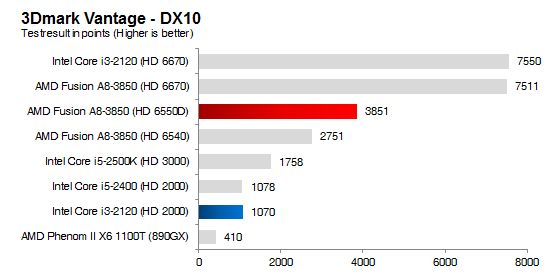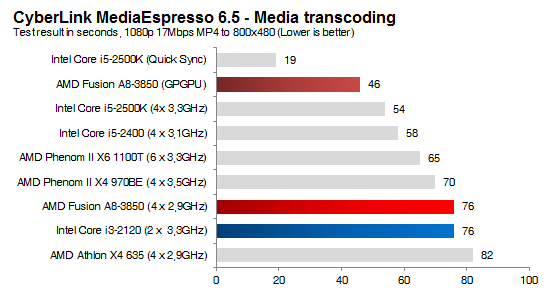Intel will release some more goodies on the coming processor architecture Ivy Bridge later this week, but already details have leaked on the updates to Sandy Bridge where it has been confirmed that the GPU will bring up to 16 EUs that will boost performance with 60% in 3DMark Vantage, enough to catch up to AMD A6 series.
Intel has GPUs with 6 or 12 EUs (Execution Units/cores) in its Sandy Bridge architecture, but in Ivy Bridge it increase the top model number to 16 EUs. This together with other optimizations will bring performance boosts up to 60% in 3DMark Vantage Performance preset. A boost of 60% sounds promising and is of course not something to sneeze at, but at the same time it is obvious that Intel needs a lot to come up to AMD’s level – in terms of raw GPU performance.
If we look to our own tests of the AMD A6 series we can see how our results in 3DMark Vantage Performance show that a 60% boost will not be enough to catch up to AMD A8 series, even if will probably catch up to the less endowed AMD A6 series.
Intel Core i5-2500K uses Intel HD Graphics 3000 with 12 EUs and would scores around 2,800 points with a performance boost of 60%. If ww take Core i7-2600K in comparison that has somewhat higher clocks with the same number of EUs the theoretic performance would be around 3,450 points. Eough to catch up to AMD A6-3650, but still without reach for AMD A8-3850 with its 400 Radeon cores.

DirectX 11 and the support for OpenCL 1.1 and OpenGL 3.1 are nice updates for Ivy Bridge. We have already been impressed by Intel’s performance in video transcoding with Quick Sync, which has been further improved now. Up to 2 times faster transcoding, or minor performance gains with better picture quality.
 Two times faster than QuickSync? We will have to update our test files.
Two times faster than QuickSync? We will have to update our test files.
The information only applies to the top model of the Ivy Bridge architecture, there will also be an entry model with less execution units, but there are no details on this.
Ivy Bridge will be made with 22 nanometer technology and will replace Sandy Bridge min the mid-range next year. Most likely around the break of Q1 or early Q2.















